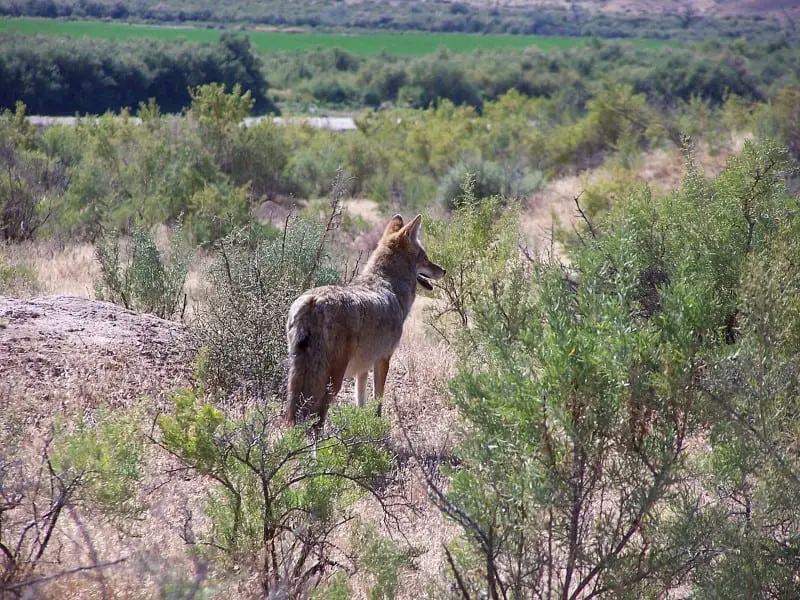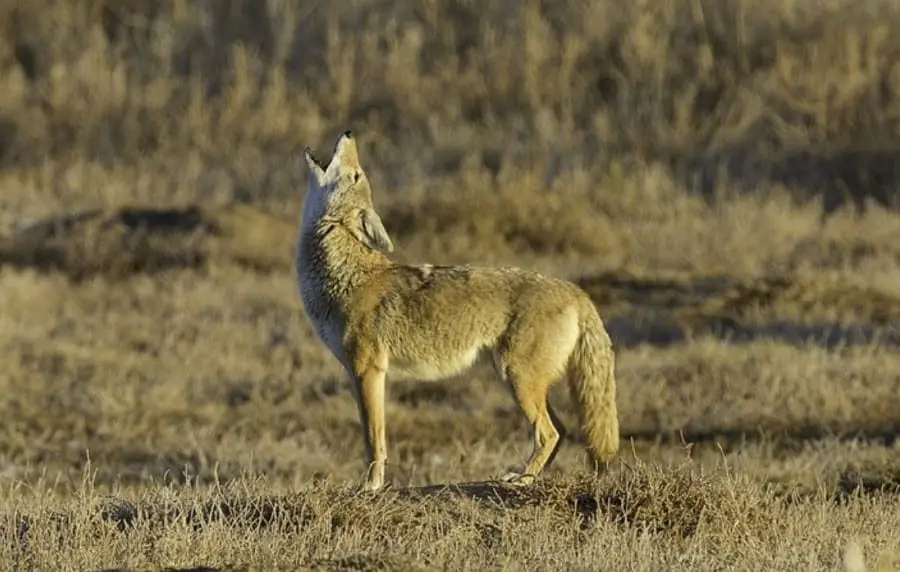In this post, we’re going to provide the very best facts about Coyotes, from meanings to behaviors and more.
Coyote (Canis latrans) is a pretty familiar creature we’re all generally aware of. They’re also often referred to as “prairie wolf” or “brush wolf”.
Coyotes are members of the canine (dog) family. Although it resembles a wolf in many ways, these two are completely different species.
But there’s much more to know about this wonderfully adapted animal. So below we have a host of interesting facts about coyotes that you may have never heard before.
Read on, or watch the video here, or at the bottom of the post from our Ranger Planet YouTube Channel.

1. Coyotes are not just in the wild
Coyotes can actually be found living in cities or urban areas. They often even invade urban parks and forest preserves and seek to own the territory. They use urine to mark their territory just like dogs do.
Since they’re similar to foxes in that they have a reputation as a pest, they do help in urban problematic populations of urban rodents.
Here are 115 amazing facts about dogs and puppies!
2. Coyotes are committed for life
Coyotes are monogamous, they find a partner and mate for life. They only take a new partner after the previous partner has died. As such coyotes remain in long-lasting or long-term relationships.
3. Coyotes raise their pups as a unit
Regardless of whether it’s a rural or urban coyote, both the male and female coyote will collectively raise and take care of their pups together, jointly sharing many parenting responsibilities.
4. Coyotes are most closely related to gray wolves
Although Coyotes are completely different species from gray wolves, they do exhibit behaviors that are closely related to gray wolves. Especially when giving birth and raising pups. Like wolves, coyotes give birth in dens.
5. Coyotes breeding with other animals
Coyotes can breed with dogs and wolves. In fact, all the eastern coyotes possess the genes of wolves and dog breeds. The cross between coyotes and wolves is known as “coywolves”, whereas the cross between coyotes and dogs is known as “coydogs”
6. Coyotes’ habitats
Coyotes are abundant throughout the United States, Canada, and Mexico. You can find coyotes in every Canadian territory and province. Although centuries back coyotes are reported to have lived mostly in deserts, they have now expanded their habitats into forests, rural and even urban areas.

7. Coyotes are fantastic swimmers
Coyotes can certainly swim. The amazing swimming skills of coyotes have resulted in them easily moving around to other islands and were, therefore, able to populate many islands. So, their swimming skills have allowed coyotes to colonize islands.
8. Coyote rare population
Snow coyotes are a rare breed of coyotes, not to be mistaken for albino coyotes. So rather than having an absence of pigment, these rare “snow coyotes” are located around Newfoundland. They have very specific genes that turn their coat white, hence the name “Snow coyotes”.
Many believe these snow coyotes are a result of cross-breeding between a coyote with a golden retriever.
9. How to pronounce coyote
Especially in Canada, if you just call this animal “Ky-aot” then you’re more of a western Canadian. Whereas if you rhyme coyote with a “Wile.E” then you’re most likely to be from Ontario.
10. The meaning of the coyote
The name coyote directly comes from an indigenous word that means barking dog”. For anyone who has heard the howl of a coyote at night, it sounds similar to a dog. But coyotes have around 11 or 12 amazing different vocalizations.
Explore interesting Facts About Arctic Wolves
Here are more facts about coyotes
11. Coyotes are fast runners
Coyotes can run up to 64 kilometers/hour (40 mph). That’s fast enough to catch even a dog. They can also jump long distances of up to 4 meters (13 feet), which adds to their agility as great hunters them great hunters.
12. Coyotes will eat almost anything
Although 90 percent of a coyote’s diet is meat, they are omnivores. And so they’ll also eat fruit, berries, and grass. They are also daring predators who kill rattlesnakes and porcupines. Coyotes even snack on insects, fish, frogs, and carrion. Much like the things foxes eat, urban coyotes will also rummage through the garbage.
There are guidelines you can follow to ensure safe interactions with coyotes and coexistence in your neighborhood.
Find out if coyotes eat snakes!
13. Coyotes have few predators but…
Coyotes have very few animals by way of predators, so the coyote population in most places is thriving.
But when the coyote population is high, diseases easily spread among the packs. This widespread disease is troublesome as it could vastly reduce the population but does serve to maintain a natural balance of numbers.
Find out if coyotes eat foxes too!
14. Coyotes have clever hunting strategies
Their hunting strategy changes depending on the type of animal they’re about to hunt and the size of the prey.
If the prey is small, the coyote will hunt alone. But if the prey is a large animal, they hunt as a pack. Especially for prey like deer, a group of coyotes will join in and work together for the hunt.
15. Coyotes have interesting variations of howl
Much like wolves, coyotes are very vocal animals and have many variations in their howling for different calls.
Coyotes use a long or lengthy howl to call or report their location and growl when they establish dominance. Yips when coyotes reunite with other pack members. Whines and whimpers when they bond, a short bark is to warn other coyotes of danger, and high-pitched bark is to gather their pups.

16. Coyotes use a special tiptoe tactic
Coyotes move silently by walking on the tip of their toes when they sense predators or any other potential danger. This makes them far less traceable by predators. They’re also extremely alert, with a great sense of smell, radar-like ears able to detect the slightest sounds, as well as good eyesight.
These senses have developed exceptionally over the years, making them challenging to hunt for their predators. Humans are one of the main predators of coyotes. This is because humans treat coyotes as pests and kill them to protect their livestock and territories.
17. Coyotes are a part of tribes, tales, traditions, and beliefs
Coyotes are famous creatures within the tales and traditions of Native Americans. They’re viewed as wily and clever beasts among the ancient Native Americans and are revered to this day.
Coyotes are also prominent figures among tribes like Pawnee, Maidu, Chinook, O’odham, Tohono, Paiute, and Ute. These tribes portray coyotes as the companion of the creator.
18. Coyotes are attracted to chemicals
There are certain chemicals that attract coyotes, they will always hone in on them and may perfume themselves with them, eat them where they can, or urinate on them.
19. National culling of coyotes
In 1914, the government called upon a national culling of coyotes in an effort to protect livestock, involving trapping, shooting, poisoning, and other methods. The numbers killed in the last century were thought to be around 20 million!
They are still hunted to this day, and around half a million are killed each year. But because more coyote litter survive, the numbers did not decline. In fact, since then, numbers have increased, and now there’s an average of 3 coyotes per square kilometer in the U.S.
Find out What Eats a Fox
20. Coyote litter
Coyotes commonly give birth to 5-7 litter at a time, but only 2-3 of these will likely survive. This is nature’s way of ensuring population levels remain stable. Unlike the wolf, if the population begins to decline, more pups will survive, as there is more food to go around. This is where the wolf was at a disadvantage and declined in numbers when hunted.
21. Coyotes and badgers
The coyote and the badger have formed an unusual symbiotic relationship when it comes to hunting and often hunts together. The coyote can hear rodents underground better, and the badger is better at digging to get to them.
22. Coyote expansion
Because their main competitor wolves have been pushed back into the far northern reaches of North America, and because of continued deforestation and cultivation, and other human influences, coyotes have expanded much further, covering almost all of North America. East to west and into New Mexico and even Alaska.
The expansion comes largely as a result of evading hunters and thereby being pushed into new areas. But the tide is turning once again as wolves are now being reintroduced into areas like Yellowstone Park …restoring the balance.
Now you need to know What Eats a Wolf!
Video Resource
Here’s a video that outlines the above 22 facts about Coyotes. See more on the Ranger Planet YouTube Channel.
Learning Resources
Continue your learning at home, or in the classroom with the following resources.
Myths and Truths About Coyotes
Coyotes are an enduring symbol of the wild and freedom, and powerful predators. This book examines the spread of coyotes across the country over the past century, and more besides.
Coyote: Children’s Book
An amazing animal picture book about coyotes for children. Ideal for home or classroom library.
To finish…
We hope this has been useful in understanding some quick-fire facts about coyotes, their behavior, their hunting methods, and much more. So check out our other articles about all the things you wondered about nature before and forgot to ask!
This content has been checked and verified by a qualified veterinary practitioner. The article has been reviewed by our editorial board and has been approved for publication in accordance with our editorial policy.
